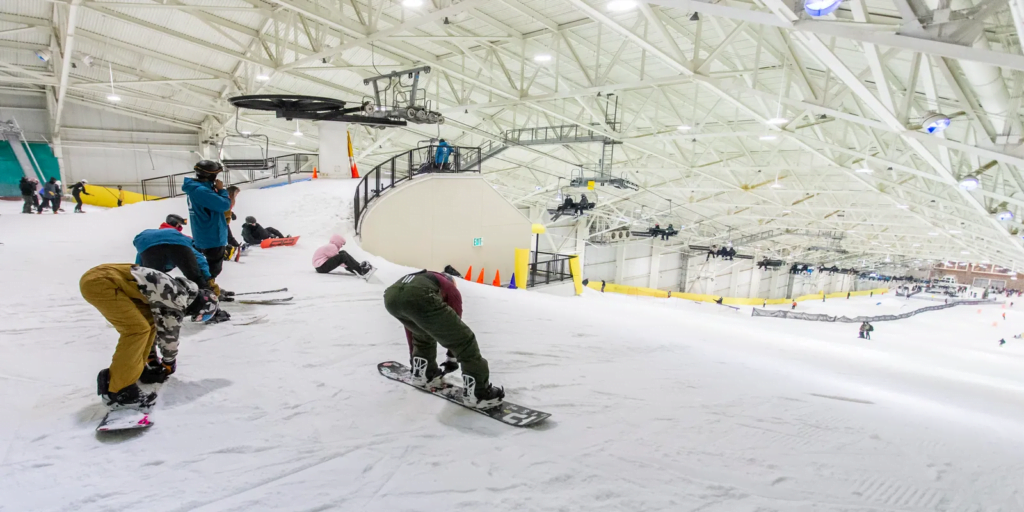The Best Indoor Snowboarding Locations in USA: Welcome to the thrilling world of indoor snowboarding! As winter sports enthusiasts eagerly anticipate the snowy season, indoor snowboarding locations across the United States offer year-round excitement and adventure. In this comprehensive guide, we’ll explore the top indoor snowboarding locations in USA, providing insights into their unique features, facilities, and experiences.

Table of Contents For Indoor Snowboarding Locations in USA
Types and Categories of Indoor Snowboarding Facilities
Snowdomes
- Description: Snowdomes are large indoor facilities equipped with artificial snow slopes, offering an authentic snowboarding experience.
- Locations: Major cities and urban areas.
- Facilities: Slopes of varying difficulty levels, snowboarding equipment rental, professional coaching services.
Ski Resorts with Indoor Snow Parks
- Description: Some ski resorts feature indoor snow parks alongside their outdoor slopes, providing additional options for snowboarding enthusiasts.
- Locations: Resort towns and mountainous regions.
- Facilities: Indoor snow parks with terrain parks, halfpipes, and freestyle features, complementing the resort’s outdoor offerings.
Indoor Snow Centers
- Description: Dedicated indoor snow centers focus solely on providing snowboarding and skiing experiences in controlled indoor environments.
- Locations: Urban areas with limited access to natural snow.
- Facilities: High-quality snow slopes, training areas, snowboarding lessons, and après-ski amenities.
Symptoms and Signs of Indoor Snowboarding Addiction
Elevated Excitement Levels
- Symptoms: Persistent excitement and anticipation leading up to indoor snowboarding sessions.
- Signs: Increased heart rate, restlessness, and eagerness to hit the slopes.
Desire for Continuous Improvement
- Symptoms: A strong desire to enhance snowboarding skills and tackle increasingly challenging slopes.
- Signs: Regular enrollment in snowboarding lessons or training programs, investment in advanced snowboarding gear.
Withdrawal Symptoms
- Symptoms: Feelings of restlessness or dissatisfaction when unable to engage in indoor snowboarding activities.
- Signs: Irritability, mood swings, and a longing for the adrenaline rush associated with snowboarding.
Causes and Risk Factors of Indoor Snowboarding Addiction
Passion for Snowboarding
- Cause: A deep-rooted passion for snowboarding and the thrill of conquering snow-covered slopes.
- Risk Factors: Individuals with a long-standing love for winter sports may be more susceptible to developing an addiction to indoor snowboarding.
Accessibility and Convenience
- Cause: The accessibility and convenience of indoor snowboarding facilities, especially in urban areas with limited access to natural snow.
- Risk Factors: Easy access to indoor snowboarding may lead to frequent participation and, subsequently, addiction.
Social Influence
- Cause: Peer pressure or social influence from friends or fellow snowboarding enthusiasts who frequent indoor snowboarding facilities.
- Risk Factors: Social pressure to participate in indoor snowboarding activities may contribute to addictive behavior.
ALSO READ: How to Set Google Maps for RV Travel
Diagnosis and Tests for Indoor Snowboarding Addiction
Self-Assessment Questionnaires
- Description: Various self-assessment questionnaires and screening tools can help individuals evaluate their relationship with indoor snowboarding.
- Examples: Addiction Severity Index (ASI), Bergen Shopping Addiction Scale (BSAS).
Clinical Interviews
- Description: Psychologists or mental health professionals conduct structured interviews to assess the severity of indoor snowboarding addiction.
- Process: Interviews may include questions about snowboarding habits, withdrawal symptoms, and the impact of snowboarding on daily life.
Diagnostic Criteria
- Description: Indoor snowboarding addiction may be diagnosed based on established criteria for behavioral addictions.
- Criteria: Compulsive engagement in indoor snowboarding despite negative consequences, withdrawal symptoms when unable to snowboard, and diminished control over snowboarding habits.
Treatment Options for Indoor Snowboarding Addiction
Cognitive-Behavioral Therapy (CBT)
- Description: CBT aims to identify and modify unhealthy thoughts and behaviors associated with indoor snowboarding addiction.
- Techniques: Cognitive restructuring, behavioral experiments, and relapse prevention strategies.
Support Groups
- Description: Support groups provide a platform for individuals struggling with indoor snowboarding addiction to share their experiences and receive encouragement from peers.
- Examples: Snowboarders Anonymous, Indoor Snowboarding Recovery Group.
Mindfulness-Based Interventions
- Description: Mindfulness practices help individuals cultivate awareness of their thoughts and emotions, reducing impulsivity and promoting self-regulation.
- Techniques: Meditation, mindful breathing exercises, and body scans.
Preventive Measures Against Indoor Snowboarding Addiction
Moderation and Balance
- Recommendation: Engage in indoor snowboarding activities in moderation, balancing them with other hobbies and interests.
- Tips: Allocate designated snowboarding days each week and explore alternative recreational activities.
Setting Boundaries
- Recommendation: Establish clear boundaries around indoor snowboarding habits to prevent excessive or compulsive behavior.
- Strategies: Set time limits for indoor snowboarding sessions and prioritize responsibilities and obligations.
Seeking Professional Help
- Recommendation: Consult a mental health professional if indoor snowboarding habits begin to interfere with daily functioning or relationships.
- Resources: Psychologists, counselors, or addiction specialists can provide personalized support and guidance.
Personal Stories of Overcoming Indoor Snowboarding Addiction
Sarah’s Story: Finding Balance
- Background: Sarah struggled with indoor snowboarding addiction, prioritizing snowboarding over her studies and social life.
- Transformation: Through therapy and self-reflection, Sarah learned to establish boundaries and find balance in her life, pursuing snowboarding as a healthy hobby rather than an obsession.
Alex’s Journey: Embracing Moderation
- Background: Alex’s passion for snowboarding led to excessive indoor snowboarding sessions, resulting in burnout and fatigue.
- Recovery: By implementing moderation techniques and diversifying his recreational activities, Alex regained control over his snowboarding habits and rediscovered his love for the sport.
Expert Insights on Indoor Snowboarding Addiction
Dr. Rebecca Lopez, Psychologist
- Quote: “Indoor snowboarding addiction can have significant psychological and social consequences, but with the right support and interventions, individuals can overcome it and lead fulfilling lives.”
John Parker, Professional Snowboarder
- Quote: “As athletes, it’s essential to recognize the difference between dedication and obsession. Indoor snowboarding should enhance our lives, not consume them.”
Conclusion For The Best Indoor Snowboarding Locations in USA
Indoor snowboarding offers exhilarating experiences and challenges for winter sports enthusiasts across the United States. While the thrill of conquering artificial slopes is undeniable, it’s crucial to maintain a healthy balance and prioritize overall well-being. By recognizing the signs of indoor snowboarding addiction, seeking support when needed, and embracing moderation, individuals can enjoy the excitement of snowboarding while safeguarding their mental and physical health. (Indoor Snowboarding Locations in USA)
Learn more: Exploring Natural Remedies for Potency: A Comprehensive Guide



